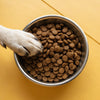Is All Freeze-Dried Dog Food Raw? Exploring the Truth Behind Freeze-Dried Diets
- Houndsy
Table of Contents
- Introduction
- Understanding Freeze-Dried Dog Food
- Nutritional Components of Freeze-Dried Dog Food
- Pros and Cons of Freeze-Dried Dog Food
- Freeze-Dried vs. Kibble: A Comparative Analysis
- The Role of Freeze-Dried Food in a Dog's Diet
- Conclusion
- Frequently Asked Questions (FAQ)
Introduction
As devoted pet owners, we all want the best for our furry companions. With the plethora of dog food options available, it can be overwhelming to navigate through the various diets. Among them, freeze-dried dog food has garnered significant attention, often touted for its convenience and nutritional benefits. But one question looms large: Is all freeze-dried dog food raw?
This inquiry is more than just semantics; it delves into the essence of what we feed our pets and the implications it has on their health. With pet health consciousness on the rise, understanding the dynamics of freeze-dried dog food can empower us to make informed decisions for our dogs’ diets.
In this blog post, we will explore the intricacies of freeze-dried dog food, including its manufacturing process, nutritional content, advantages and disadvantages, and how it compares to traditional kibble and raw diets. By the end, we aim to provide clarity on the question at hand while offering guidance for pet owners contemplating dietary changes for their pets.
So, let's embark on this journey together as we analyze the freeze-dried dog food landscape, keeping in mind our mission at Houndsy to simplify and elevate the dog-feeding experience.
Understanding Freeze-Dried Dog Food
What is Freeze-Dried Dog Food?
Freeze-dried dog food is a type of pet food that has undergone a specific preservation process known as freeze-drying. This method involves freezing the food and then removing moisture from it through sublimation—where ice turns directly into vapor, bypassing the liquid stage. The result is a lightweight, shelf-stable product that retains much of the original flavor, aroma, and nutritional value of the raw ingredients.
The key characteristic of freeze-dried foods is that they often contain raw ingredients, such as meat, fruits, and vegetables. However, it's essential to note that not all freeze-dried dog food is inherently raw. Some varieties may include cooked ingredients or be processed in ways that alter their raw nature.
The Freeze-Drying Process
The freeze-drying process consists of several stages to ensure that the integrity of the food is preserved:
- Freezing: The food is rapidly frozen to prevent the formation of large ice crystals that could damage cellular structures.
- Sublimation: The frozen food is placed in a vacuum chamber where heat is applied. This causes the ice to vaporize without passing through a liquid state, effectively removing moisture.
- Secondary Drying: Any remaining moisture is removed, ensuring a stable product that can be safely stored without refrigeration.
This careful technique allows freeze-dried products to maintain their nutritional content while extending shelf life significantly compared to fresh or raw food.
Nutritional Components of Freeze-Dried Dog Food
Raw Ingredients and Nutritional Value
Most freeze-dried dog foods are formulated with raw ingredients, making them a popular choice for pet owners seeking to provide a diet closer to what their dogs would naturally consume in the wild. Common ingredients found in freeze-dried dog food include:
- Meat (beef, chicken, turkey, fish)
- Fruits and Vegetables (carrots, peas, blueberries)
- Natural Preservatives (like mixed tocopherols)
- Vitamins and Minerals (to ensure dietary balance)
- Probiotics (for digestive health)
Benefits of a Raw Diet
Feeding dogs a raw diet, including freeze-dried options, is believed to offer various advantages:
- High Protein Content: Raw diets are often rich in protein, which is essential for muscle development and overall health.
- Digestibility: Many dogs find raw diets easier to digest, leading to better nutrient absorption.
- Natural Preservation of Nutrients: The freeze-drying process helps retain essential vitamins and minerals that might be lost in traditional cooking methods.
However, it is crucial to remember that while many freeze-dried diets are marketed as raw, not all adhere to the same standards of ingredient sourcing and processing.
Pros and Cons of Freeze-Dried Dog Food
Advantages of Freeze-Dried Dog Food
- Convenience: Freeze-dried dog food is lightweight, easy to store, and does not require refrigeration, making it ideal for travel.
- Long Shelf Life: Due to the removal of moisture, freeze-dried foods can last for extended periods without spoiling.
- Nutrient Retention: The freeze-drying process preserves the nutritional integrity of the raw ingredients, providing a dense source of vitamins and minerals.
- Palatability: Many dogs find freeze-dried food to be more flavorful and appealing than traditional kibble.
Disadvantages of Freeze-Dried Dog Food
- Cost: Freeze-dried dog food often comes with a higher price tag compared to standard kibble, primarily due to the processing involved.
- Potential Pathogen Risks: While freeze-drying reduces moisture, it does not eliminate all pathogens. Bacteria like Salmonella can still be present, posing a risk to both pets and humans.
- Incomplete Nutrition: Some freeze-dried options may not meet the complete and balanced nutrition standards set by the Association of American Feed Control Officials (AAFCO). It's essential to check packaging for AAFCO statements.
- Rehydration Requirement: While some pet owners prefer to serve it dry, others may need to rehydrate freeze-dried food, which adds an extra step to mealtime preparation.
Freeze-Dried vs. Kibble: A Comparative Analysis
Processing Differences
Kibble is the most commonly found dog food on the market. It undergoes high-temperature processing that cooks the ingredients, potentially compromising some nutritional value. In contrast, freeze-dried food is minimally processed, retaining much of the raw ingredients' benefits.
Nutritional Comparison
Kibble typically has a lower protein content than freeze-dried raw options and often contains fillers like grains or vegetables to enhance texture. Freeze-dried foods, on the other hand, focus on high protein and low processing levels, making them a more nutrient-dense choice for many dogs.
Cost Consideration
When comparing costs, kibble is generally more budget-friendly. However, freeze-dried foods offer unique advantages in terms of nutritional quality, which can lead to healthier pets in the long run.
Safety Considerations
Both kibble and freeze-dried diets have their safety concerns. While kibble is cooked and thus less likely to harbor pathogens, freeze-dried foods require careful handling to avoid contamination. It’s essential to follow proper hygiene practices when serving freeze-dried food to ensure the safety of both pets and humans.
The Role of Freeze-Dried Food in a Dog's Diet
Incorporating Freeze-Dried Food into Your Pet's Routine
For pet owners considering freeze-dried food, it's crucial to transition gradually. Mixing freeze-dried food with kibble or other diets can help ease the transition while allowing you to monitor your dog’s reaction.
Consulting Your Veterinarian
Before making any significant dietary changes, consulting your veterinarian is vital. They can provide personalized advice based on your dog's health, age, and nutritional needs. This ensures that you are making the best decision for your furry friend.
Houndsy’s Commitment to Quality
At Houndsy, we understand the importance of quality in pet nutrition. Our flagship product, the Houndsy Kibble Dispenser, is designed to make feeding time easier, allowing you to provide your dog with the best possible diet without the mess and hassle. Our commitment to convenience, design excellence, and pet well-being is at the heart of everything we do. To elevate your dog-feeding experience, consider exploring the Houndsy Kibble Dispenser.
Conclusion
Navigating the world of dog food can be complex, especially when considering options like freeze-dried diets. While many freeze-dried dog foods contain raw ingredients, not all can be classified as raw in the traditional sense. Understanding the differences between freeze-dried and other types of dog food is crucial for making informed choices for our pets.
As we’ve discussed, freeze-dried food offers unique advantages, including nutritional benefits and convenience, but it also comes with considerations regarding safety and cost. Ultimately, the best diet for your dog will depend on their specific needs and your preferences as a pet owner.
Reflecting on your feeding routine, are you ready to explore the world of freeze-dried dog food? With the right information, you can make choices that promote your pet's health and happiness.
Frequently Asked Questions (FAQ)
Is all freeze-dried dog food raw?
Not all freeze-dried dog food is raw. While many freeze-dried options are made from raw ingredients, some may include cooked components or be processed in ways that alter their raw nature. Always check the ingredient list and nutritional information.
What are the benefits of freeze-dried dog food compared to kibble?
Freeze-dried dog food typically contains higher protein levels and retains more nutrients due to minimal processing. It also offers convenience with a long shelf life and can be lighter and easier to store than kibble.
Are there any safety concerns with feeding freeze-dried dog food?
Yes, freeze-dried dog food can pose risks of bacterial contamination, including Salmonella. Proper handling and hygiene practices are essential to minimize these risks.
How should I transition my dog to a freeze-dried diet?
Transition gradually by mixing freeze-dried food with your dog's current diet. Monitor their reaction and consult your veterinarian for personalized advice.
Can freeze-dried food be served dry, or does it need to be rehydrated?
Freeze-dried food can be served both dry or rehydrated, depending on your dog's preference. Rehydrating can make the food easier to chew, especially for older dogs or those with dental issues.
By understanding freeze-dried dog food and its implications, we can make choices that enhance our dogs' health while simplifying the feeding experience. For more insights and tips on elevating your pet care routine, keep exploring our resources at Houndsy!












